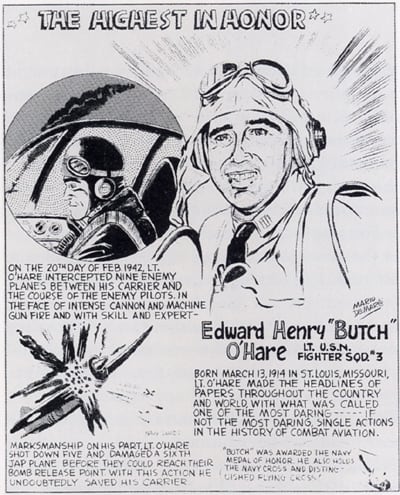
The lives of the O’Hare family and of most Americans changed dramatically only three months later when the Japanese attacked Pearl Harbor on December 7, 1941. On the following days, Butch left with his fighter squadron on a mission in the Pacific, and his wife returned to her parents’ home in Keokuk, Iowa. The times were especially tense. American forces won precious few victories because of personnel and aircraft shortages left in the wake of Pearl Harbor. Young O’Hare found himself a pilot and section leader of Fighting Squadron 3, assigned to protect the aircraft carrier Lexington.

O’Hare commanding officer, Lt. Comm. John S. Thach ( right), gongratulates O’Hare after his moment of destiny. U.S. Navy Photograph.
Word of Butch O’Hare’s feat made its way back to America a few days later, and the reaction was instantaneous. The tall bashful flyer became a national hero. He returned to the United States several weeks later, and on April 21,1942, with his wife and his mother at his side, he was awarded the Congressional Medal of Honor by President Franklin Roosevelt. Roosevelt’s citation stated that, „As a result of his gallant action, one of the most daring, if not the most daring single action in the history of combat aviation, he undoubtedly saved his carrier from serious damage!’
Roosvelt promoted O’Hare from lieutenant junior grade to lieutenant senior grade. Almost inaudibly told the president, „That is very nice, thank you very much.”

President Franklin D. Roosvelt awards o’ Hare the Congresional Medal of Honor on April 21, 1942, while his wife Rita looks on. Chicago-Sun-Times.
Butch O’Hare seemed uncomfortable as a war hero. On April 26, 1942, he returned home to St. Louis. After a huge welcome at Lambert Airport, he rode in parade past 60,000 wildly cheering St. Louisans who turned out despite the rain to native son. Mayor William Dee Williams awarded him the key to the city and a navigator’s gold chronograph. O’Hare helped of many war bond drives, noting, : Just give us enough trained men, enough ships to approach even terms, and we’ll come out on top”
Despite all that had happened, the war was just beginning for Butch O’Hare. After a brief leave, to his squadron, and on August 31, 1943, he led repeated air raids against enemy installations on Marcus Island. With what navy officials would later term „courageous disregard for his own personal safety” he led his squadron in destroying all grounded aircraft and most of the defensive installations. For this he was awarded the Distinguished Flying Cross.

Illustration By Mario Demarco. U.S. Navy photographer
To be continued.
Source:
CHICAGO HISTORY
The Magazine of the Chicago Historical Society, Fall and Winter 1988- 89. Volume XVII, Number 3 and 4
YESTERDAY’S CITY BY PERRY R. DUIS
Part I
https://polishnews.com/historia-history/chicago-history/4379-yesterday-s-city-by-perry-r-duis
